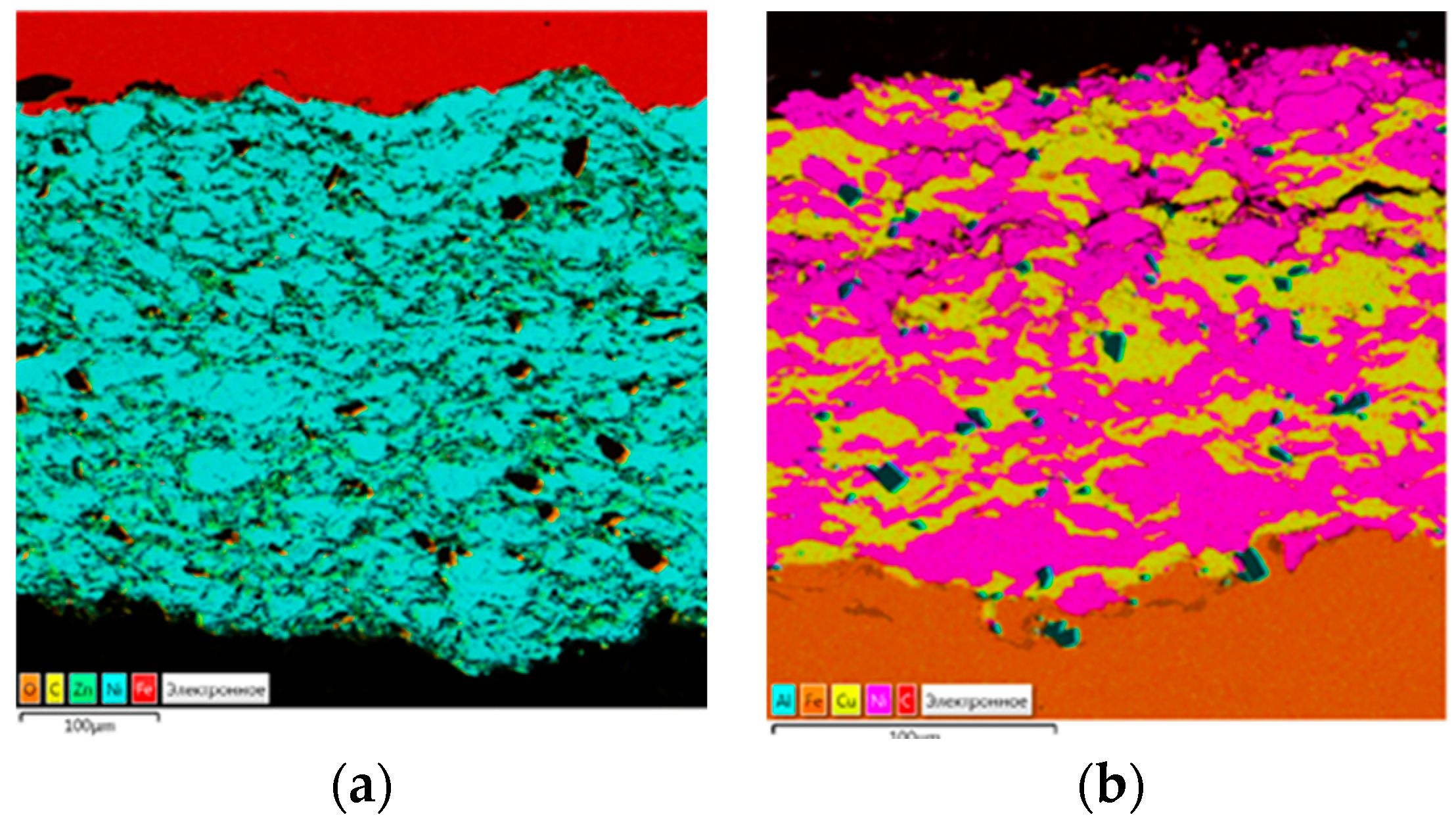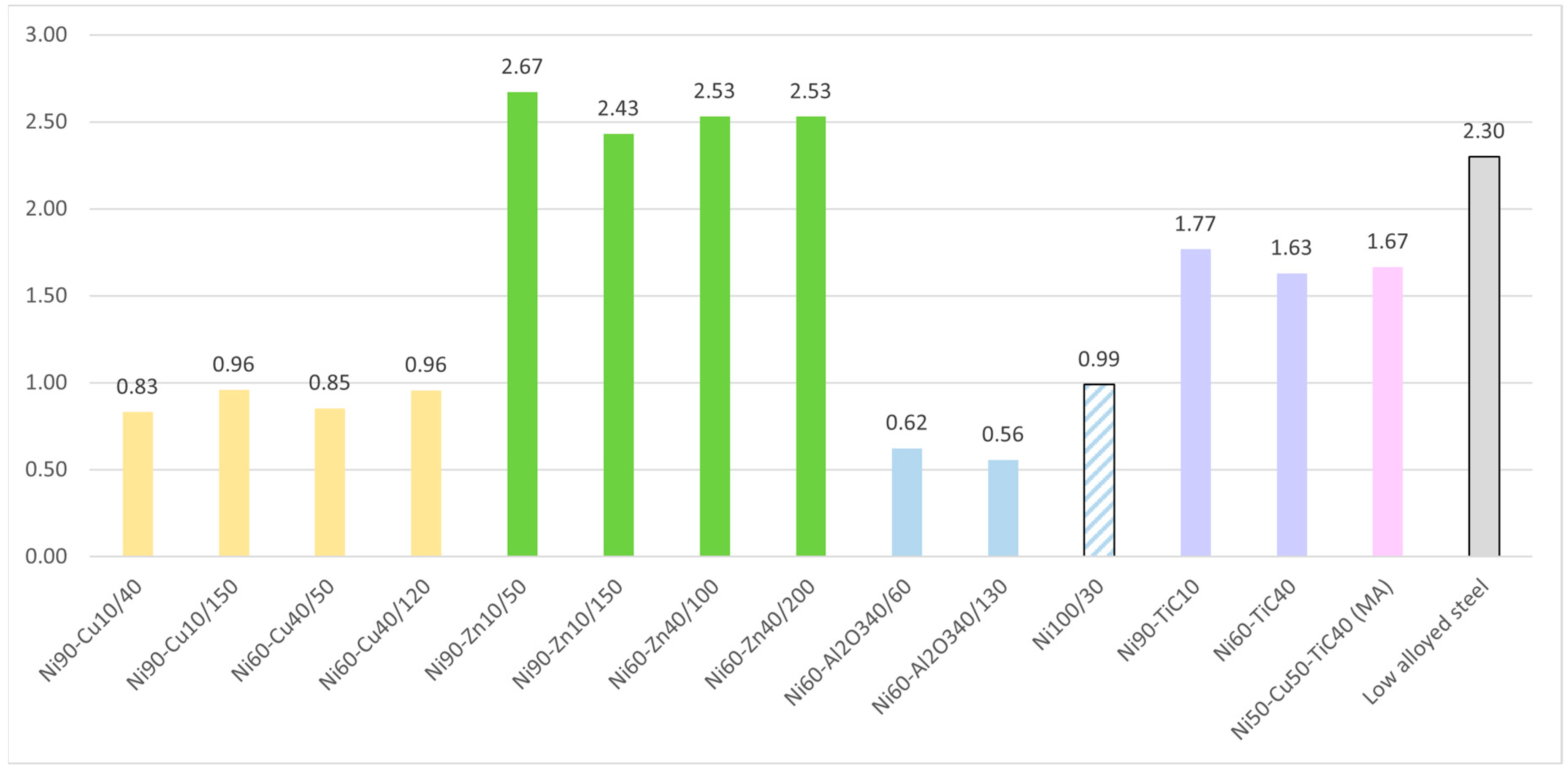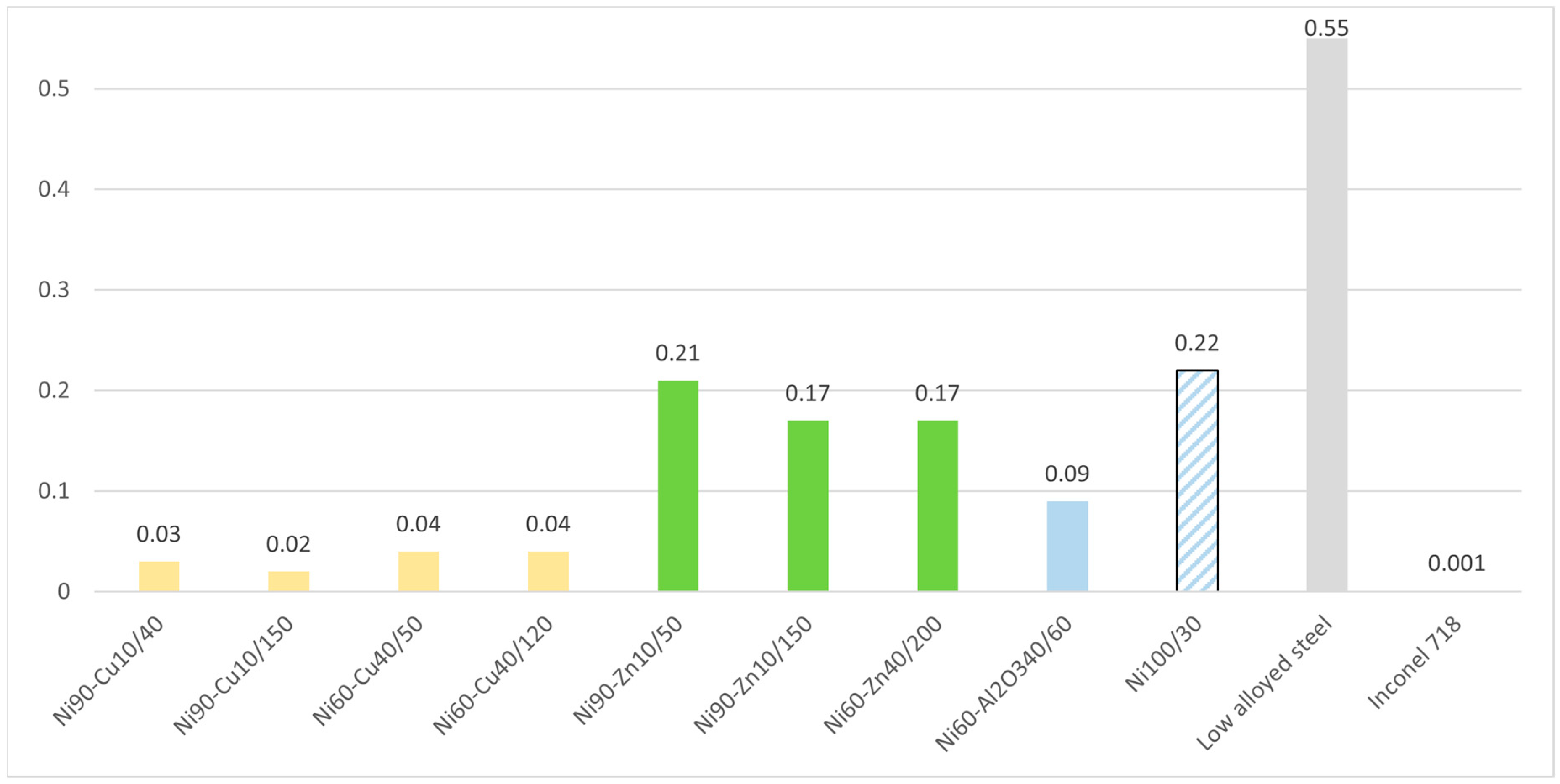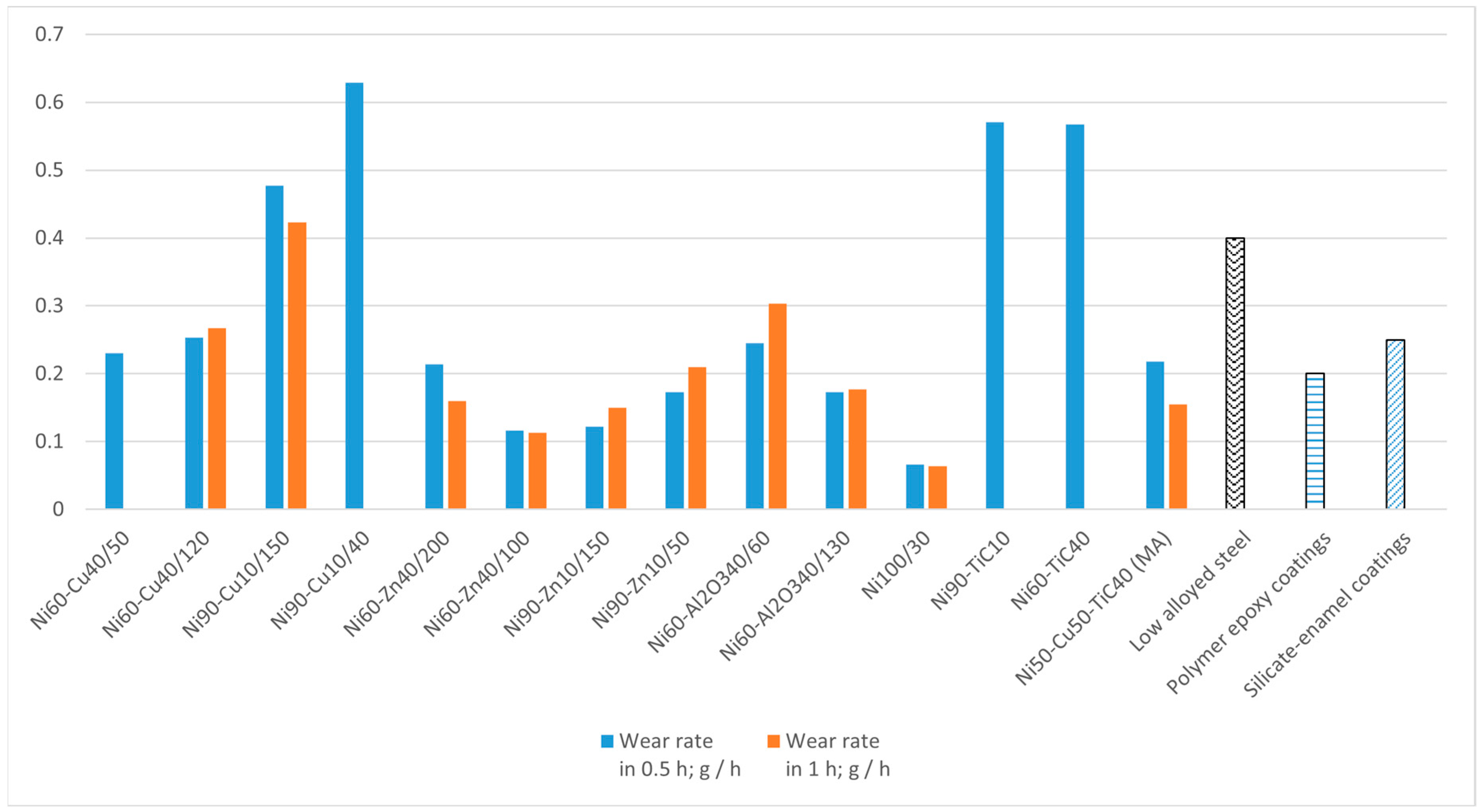Ni-Based Coatings for Oil and Gas Industry Fabricated by Cold Gas Spraying †
Abstract
:1. Introduction
2. Materials and Methods
2.1. Corrosion Tests
2.2. Hydroabrasive Testing
2.3. Microstructure and Microhardness Investigation
3. Results and Discussion
3.1. Characterization of Microstructure of Coatings
3.2. Characterization of Corrosion Properties
3.3. Characterization of Wear Properties
4. Conclusions
- It was shown that the coating based on Ni–Zn has the lowest corrosion characteristics (in the simulated oilfield conditions, the corrosion rate is 0.17–0.2 mm/year), though these coatings have the highest wear resistance characteristics. However, the protective effect of zinc allows them to be used as corrosion-resistant, while at the same time being economically attractive;
- The samples of nickel–copper coatings have high corrosion resistance, but low wear resistance due to their low hardness. Applying coatings from mechanically alloyed powders of nickel–copper is not applied practically without titanium carbide;
- The nickel samples have low resistance to corrosion, but high resistance to hydro-abrasive wear;
- Al2O3/TiC additives give ambiguous results in the studied properties. Specimens with Al2O3 have a low hydroabrasive wear and high corrosion resistance; the introduction of TiC particles was not effective in improving these characteristics;
- All the studied coating specimens have a sufficiently high adhesion before and after testing in autoclave;
- A thickness of 40–60 microns provides sufficient performance for the studied coatings.
Institutional Review Board Statement
Informed Consent Statement
References
- Heidersbach, R. Metallurgy and Corrosion Control in Oil and Gas Production. In Wiley Series in Corrosion, 2nd ed.; John Wiley & Sons: Hoboken, NJ, USA, 2011; 281p, ISBN 13:9780470248485. [Google Scholar]
- Craig, B.D. Oilfield Metallurgy and Corrosion, 3rd ed.; MetCorr, 2014; 335p, ISBN 0615961355. [Google Scholar]
- Sankara, P. Corrosion Control in the Oil and Gas Industry; Elsevier: Amsterdam, The Netherlands; Gulf professional Publ.: London, UK, 2013; 1020p, ISBN 9780123970220. [Google Scholar]
- Rebak, R.B. Pitting characteristics of nickel alloys—A review. In NACE International Corrosion Conference Proceedings; NACE International, 2016; №7450. [Google Scholar]
- MacLean, M.; Farhat, Z.; Jarjoura, G.; Fayyad, E.; Abdullah, A.; Hassan, M. Fabrication and investigation of the scratch and indentation behavior of new generation Ni-P-nano-NiTi composite coating for oil and gas pipelines. Wear 2019, 426-427, 265–276. [Google Scholar] [CrossRef]
- Wang, C.; Farhat, Z.; Jarjoura, G.; Hassan, M.K.; Abdullah, A.M. Indentation and erosion behavior of electroless Ni-P coating on pipeline steel. Wear 2017, 376–377, 1630–1639. [Google Scholar] [CrossRef]
- Kumar, N.P.; Shanmugam, N.S. Some studies on nickel based Inconel 625 hard overlays on AISI 316L plate by gas metal arc welding based hardfacing process. Wear 2020, 456–457, 203394. [Google Scholar] [CrossRef]
- Sahoo, C.K.; Masanta, M. Microstructure and mechanical properties of TiC-Ni coating on AISI304 steel produced by TIG cladding process. J. Mater. Process. Technol. 2017, 240, 126–137. [Google Scholar] [CrossRef]
- Pawlowski, L. The Science and Engineering of Thermal Spray Coatings, 2nd ed.; John Wiley & Sons Ltd.: Hoboken, NJ, USA, 2008. [Google Scholar] [CrossRef]
- Brandolt, C.S.; Vega, M.R.O.; Menezes, T.L.; Schroeder, R.M.; Malfatti, C.F. Corrosion behavior of nickel and cobalt coatings obtained by high-velocity oxy-fuel (HVOF) thermal spraying on API 5CT P110 steel. Mater. Corros. 2015, 67, 368–377. [Google Scholar] [CrossRef]
- Ermakov, B.S.; Alkhimenko, A.A.; Shaposhnikov, N.O.; Ermakov, S.B.; Shatsky, T.E.; Igolkin, A.F. The use of sprayed powders to create coatings in the welds of oilfield pipelines. IOP Conf. Series: Mater. Sci. Eng. 2020, 826. [Google Scholar] [CrossRef]
- Brissonneau, L.; Vahlas, C. Precursors and operating conditions for the metal-organic chemical vapor deposition of nickel films. Annales de Chimie Science des Matériaux 2000, 25, 81–90. [Google Scholar] [CrossRef]
- Bowden, C.; Matthews, A. A study of the corrosion properties of PVD Zn-Ni coatings. Surf. Coatings Technol. 1995, 76–77, 508–515. [Google Scholar] [CrossRef]
- Geraschenkov, D.A.; Vasiliev, A.F.; Farmakovsky, B.V.; Mashek, A.C. Study of the flow temperature in the process of cold gas-dynamic spraying of functional coatings. Mater. Sci. 2014, 2, 87–96. [Google Scholar]
- Gerashchenkov, D.A.; Bobkova, T.I.; Vasiliev, A.F.; Kuznetsov, P.A.; Samodelkin, E.A.; Farmakovsky, B. Functional protective coatings of nickel-based alloys. Vopr. Mater. 2019, 1, 110–114. [Google Scholar] [CrossRef]
- Meng, M.; Leech, A.; Le, H. Mechanical properties and tribological behavior of electroless Ni–P–Cu coatings on corrosion-resistant alloys under ultrahigh contact stress with sprayed nanoparticles. Tribol. Int. 2019, 139, 59–66. [Google Scholar] [CrossRef]
- Li, B.; Mei, T.; Li, D.; Du, S.; Zhang, W. Structural and corrosion behavior of Ni-Cu and Ni-Cu/ZrO2 composite coating electrodeposited from sulphate-citrate bath at low Cu concentration with additives. J. Alloy. Compd. 2019, 804, 192–201. [Google Scholar] [CrossRef]
- Hammami, O. Influence of Zn-Ni alloy electrodeposition techniques on the coating corrosion behavior in chloride solution. Surf. Coatings Technol. 2009, 203, 2863–2870. [Google Scholar] [CrossRef]
- Shourgeshty, M.; Aliofkhazraei, M.; Karimzadeh, A.; Poursalehi, R. Corrosion and wear properties of Zn–Ni and Zn–Ni–Al2O3 multilayer electrodeposited coatings. Mater. Res. Express 2017, 4, 096406. [Google Scholar] [CrossRef]
- Chen, L.; Wang, L.; Zeng, Z.; Zhang, J. Effect of surfactant on the electrodeposition and wear resistance of Ni-Al2O3 composite coatings. Mater. Sci. Eng. A 2006, 434, 319–325. [Google Scholar] [CrossRef]
- Szczygieł, B.; Kołodziej, M. Corrosion resistance of Ni/Al2O3 coatings in NaCl solution. Trans. IMF 2005, 83, 181–187. [Google Scholar] [CrossRef]
- Ghaziof, S.; Kilmartin, P.A.; Gao, W. Electrochemical studies of sol-enhanced Zn–Ni–Al2O3 composite and Zn–Ni alloy coatings. J. Electroanal. Chem. 2015, 755, 63–70. [Google Scholar] [CrossRef]
- Oryshchenko, A.S.; Gerashchenkov, D.A. Aluminum matrix functional coatings with high microhardness on the basis of Al–Sn+Al2O3 composite powders fabricated by cold gas dynamic spraying. Inorg. Mater. Appl. Res. 2016, 7, 863–867. [Google Scholar] [CrossRef]
- ASTM G3-14 Standard Practice for Conventions Applicable to Electrochemical Measurements in Corrosion Testing. Available online: https://www.astm.org/Standards/G3 (accessed on 1 April 2021).
- Alekseeva, E.; Galata, L.; Lapechenkov, A.; Kovalev, M. Evaluation of Corrosion Resistance of Nickel-based Alloy EP718 for use in Hydrogen Sulphide Containing Environment. E3S Web Conf. 2021, 225, 03001. [Google Scholar] [CrossRef]
- Kovalev, M.; Alekseeva, E.; Shaposhnikov, N. Investigation of hydroabrasive resistance of internal anti-corrosion coatings used in the oil and gas industry. IOP Conf. Series Mater. Sci. Eng. 2020, 889, 012020. [Google Scholar] [CrossRef]





| Sample | Chemical Composition, wt.% | Thickness, ±5 μm |
|---|---|---|
| Ni90–Cu10/150 | Ni = 90%, Cu = 10% | 150 |
| Ni90–Cu10/40 | Ni = 90%, Cu = 10% | 40 |
| Ni60–Cu40/120 | Ni = 60%, Cu = 40% | 120 |
| Ni60–Cu40/50 | Ni = 60%, Cu = 40% | 50 |
| Ni60–Zn40/100 | Ni = 60%, Zn = 40 % | 100 |
| Ni60–Zn40/200 | Ni = 60%, Zn = 40% | 200 |
| Ni90–Zn10/150 | Ni = 90 %, Zn = 10 % | 150 |
| Ni90–Zn10/50 | Ni = 90%, Zn = 10% | 50 |
| Ni60–Al2O340/130 | Ni = 60%, Al2O3 = 40% | 130 |
| Ni60–Al2O340/60 | Ni = 60%, Al2O3 = 40% | 60 |
| Ni100/30 | Ni = 100% | 30 |
| Ni90–TiC10 | Ni = 90%, TiC = 10% | 70 |
| Ni60–TiC40 | Ni = 60%, TiC = 40% | 70 |
| Ni50–Cu50–TiC40 (MA)Mechanically Alloyed | Ni = 50%, Cu = 50% | 30 |
| Nickel Coating Type | Porosity, Unit/cm2 | Microhardness, HV |
|---|---|---|
| Ni–Сu | 0.6 | 90 |
| Ni–Zn | 2.1 | 170 |
| Ni–Al2O3 | 0.5 | 130 |
| Ni | 1.1 | 185 |
| Ni–TiC | 1.1 | 90 |
| Ni–Cu–TiC (MA) | 1.2 | 100 |
| Sample | Adhesion before, MPa | Adhesion after, MPa |
|---|---|---|
| Ni60–Cu40/50 | 6.36 | 4.04 |
| Ni60–Cu40/120 | 6.61 | 4.40 |
| Ni90–Cu10/150 | 6.82 | 6.41 |
| Ni90–Cu10/40 | 4.83 | 5.87 |
| Ni60–Zn40/100 | 6.65 | 4.50 |
| Ni60–Zn40/200 | 6.24 | 5.25 |
| Ni90–Zn10/150 | 5.72 | 5.36 |
| Ni90–Zn10/50 | 7.81 | 7.54 |
| Ni60–Al2O340/130 | 9.34 | 8.89 |
| Ni100/30 | 5.85 | 7.95 |
| Ni90–TiC10 | 9.57 | 4.70 |
| Ni60–TiC40 | 7.54 | 5.89 |
| Ni50–Cu50–TiC40 (MA) | 4.80 | 4.00 |
Publisher’s Note: MDPI stays neutral with regard to jurisdictional claims in published maps and institutional affiliations. |
© 2021 by the authors. Licensee MDPI, Basel, Switzerland. This article is an open access article distributed under the terms and conditions of the Creative Commons Attribution (CC BY) license (https://creativecommons.org/licenses/by/4.0/).
Share and Cite
Alekseeva, E.; Shishkova, M.; Strekalovskaya, D.; Gerashchenkov, D.; Glukhov, P. Ni-Based Coatings for Oil and Gas Industry Fabricated by Cold Gas Spraying. Mater. Proc. 2021, 3, 2. https://doi.org/10.3390/IEC2M-09388
Alekseeva E, Shishkova M, Strekalovskaya D, Gerashchenkov D, Glukhov P. Ni-Based Coatings for Oil and Gas Industry Fabricated by Cold Gas Spraying. Materials Proceedings. 2021; 3(1):2. https://doi.org/10.3390/IEC2M-09388
Chicago/Turabian StyleAlekseeva, Ekaterina, Margarita Shishkova, Darya Strekalovskaya, Dmitry Gerashchenkov, and Pavel Glukhov. 2021. "Ni-Based Coatings for Oil and Gas Industry Fabricated by Cold Gas Spraying" Materials Proceedings 3, no. 1: 2. https://doi.org/10.3390/IEC2M-09388
APA StyleAlekseeva, E., Shishkova, M., Strekalovskaya, D., Gerashchenkov, D., & Glukhov, P. (2021). Ni-Based Coatings for Oil and Gas Industry Fabricated by Cold Gas Spraying. Materials Proceedings, 3(1), 2. https://doi.org/10.3390/IEC2M-09388





